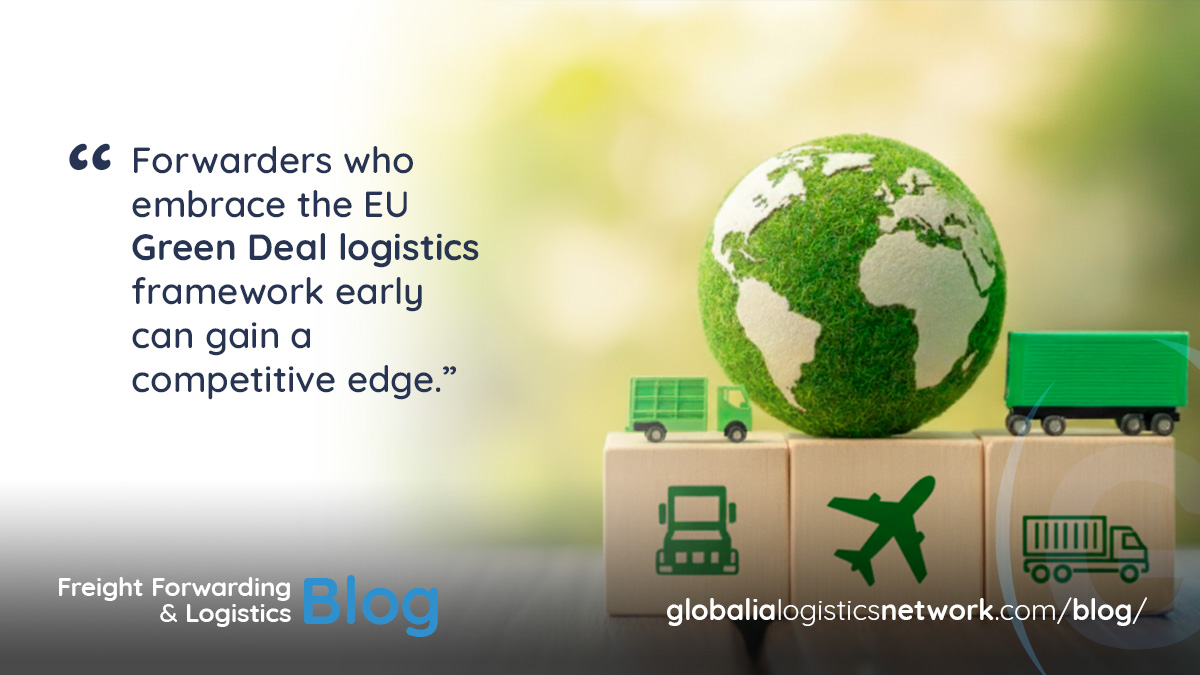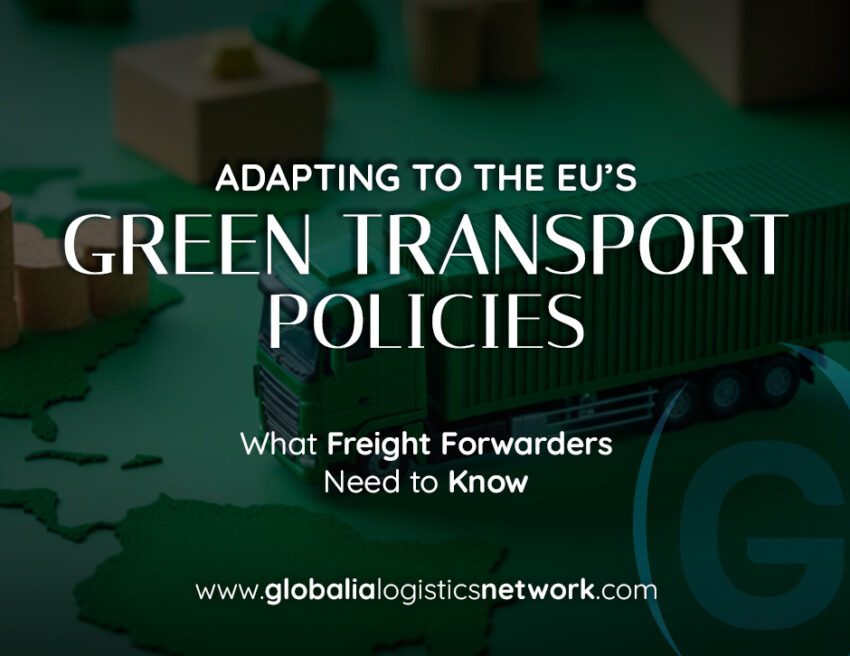The European Union is accelerating its commitment to sustainability, and logistics is at the forefront of this transformation. The EU’s green transport policies are reshaping how freight forwarders operate, requiring both strategic planning and operational adjustments. From carbon reduction measures to sustainable fuels and the EU Emissions Trading System, understanding these regulations is essential for logistics companies operating within the European market.
Understanding the EU’s Green Transport Policies
The EU green transport policies form part of the broader EU Green Deal logistics framework, aimed at achieving climate neutrality by 2050. These policies affect every aspect of transportation, from road freight and maritime shipping to aviation. For logistics companies, this means adjusting operational strategies, investing in greener technologies, and ensuring compliance with evolving rules.
Green transportation initiatives under EU transport policy focus on reducing carbon emissions, increasing energy efficiency, and encouraging the use of low-emission vehicles and fuels. Sustainable logistics EU practices include route optimization, electrification of fleets, adoption of sustainable aviation fuel, and collaboration with green-certified ports and terminals. The goal is not just compliance but also positioning as a forward-thinking, environmentally responsible partner in international supply chains.
A key question many freight forwarders ask is: how does green transport work in practice? It’s about integrating eco-friendly practices into everyday logistics operations. For example, using energy-efficient vehicles, leveraging intermodal transport to reduce emissions, and implementing digital tools to monitor fuel consumption and carbon output.

Key Components of EU Green Transport Policies
Several elements define the EU green transition for logistics, and forwarders must understand each to stay compliant:
-
EU Emissions Trading System (ETS) for Logistics
The EU ETS is expanding to include sectors beyond energy, affecting shipping and aviation. Forwarders need to understand how the EU Emissions Trading System works for shipping and air freight. Essentially, it puts a price on carbon, incentivizing companies to reduce emissions. Participating companies must monitor emissions, purchase allowances, and report compliance. This encourages the adoption of greener transport methods. -
Carbon Border Adjustment Mechanism (CBAM) Logistics
The CBAM ensures that imported goods are subject to the same carbon pricing as products made in the EU. For freight forwarders, this means considering the carbon footprint of shipments coming from non-EU countries and helping clients comply with reporting requirements. -
Sustainable Aviation Fuel (SAF) Requirements EU
Airlines and air freight carriers are required to use increasing percentages of SAF. Forwarders coordinating air shipments need to factor in these requirements when planning routes, calculating costs, and advising clients on compliance. -
Road and Rail Electrification
EU transport policy supports a shift to electric trucks, hybrid vehicles, and electrified rail networks. Forwarders using road transport within the EU must consider fleet upgrades or partnerships with green-certified carriers. -
Operational Efficiency and Digitalization
The EU encourages the use of data and technology to optimize routes, reduce empty runs, and improve logistics efficiency. Sustainable logistics EU practices include AI-based route planning, fuel monitoring software, and collaborative freight networks.
How Freight Forwarders Can Comply
Compliance with the EU’s green transport policies is not optional if companies want to maintain market access and remain competitive. Here’s how freight forwarders can approach it:
-
Assess Current Operations
Conduct a carbon audit to understand emissions across transportation modes. Identify high-impact areas and prioritize greener alternatives. -
Upgrade Vehicles and Equipment
Investing in electric or hybrid vehicles, low-emission ships, or energy-efficient handling equipment can significantly reduce emissions. -
Leverage Intermodal Transport
Combining road, rail, and maritime transport allows for lower carbon footprints. Rail and shipping typically produce fewer emissions per ton-kilometer than road transport. -
Integrate Digital Solutions
Tools that track fuel consumption, emissions, and route efficiency help ensure compliance and reduce costs. This aligns with the digital transformation focus of sustainable logistics EU initiatives. -
Stay Informed on Regulatory Changes
The EU’s green transition is ongoing, with updates to SAF requirements, ETS rules, and carbon reporting standards. Freight forwarders must monitor EU logistics news and policy updates to stay ahead. -
Educate Clients
Forwarders can add value by advising clients on how to comply with EU green transport rules, including reporting requirements and carbon footprint considerations. This positions them as trusted partners in sustainable supply chains.
Challenges and Opportunities
Adapting to EU green transport policies presents both challenges and opportunities.
Challenges include:
-
Initial investment in low-emission vehicles or equipment
-
Complexity in tracking emissions across multiple modes and borders
-
Adjusting pricing structures to account for carbon costs
Opportunities include:
-
Access to new markets that prioritize sustainability
-
Differentiation as a green-forward logistics provider
-
Cost savings from energy efficiency and optimized operations
Forwarders who embrace the EU Green Deal logistics framework early can gain a competitive edge. Clients increasingly prefer partners that demonstrate commitment to sustainability, making green transportation a strategic advantage, not just a compliance requirement.
How Does Green Transport Work for Freight Forwarders?
Understanding how green transport works is crucial for operational planning. It starts with a commitment to low-carbon modes of transport. Road freight companies may adopt electric trucks for urban delivery, while maritime logistics firms can invest in cleaner fuel alternatives. Rail transport is inherently greener, so maximizing rail usage within multimodal solutions is a key strategy.
Data-driven operations play a significant role. By monitoring fuel usage, idle times, and route efficiency, forwarders can reduce emissions while improving cost-effectiveness. Collaboration across the supply chain—such as shared warehousing, backhauls, and container optimization further enhances sustainability. Sustainable logistics EU practices also encourage continuous monitoring and reporting. Forwarders need to maintain records of emissions, fuel types, and compliance with SAF mandates or ETS obligations, ensuring transparency for regulators and clients alike.
Looking Ahead: The Future of Sustainable Logistics in the EU
The EU is not slowing down its green transition. Forwarders should anticipate tighter emissions standards, broader inclusion of transport modes in the EU Emissions Trading System, and stricter enforcement of the carbon border adjustment mechanism logistics rules. Sustainable logistics EU practices will evolve to include innovations in electrification, AI-driven route optimization, and carbon-neutral shipping methods. By staying proactive, freight forwarders can position themselves as leaders in sustainable logistics, attract environmentally conscious clients, and reduce long-term operational risks. The shift toward green transport is both inevitable and profitable for those who adapt early.
Conclusion
The EU’s green transport policies are transforming the logistics landscape. Freight forwarders must navigate a complex regulatory environment that includes carbon pricing, sustainable aviation fuel requirements, emissions reporting, and electrification mandates. Understanding how green transport works and implementing sustainable logistics EU practices is now essential for competitiveness. Forwarders who proactively adopt green transportation measures, leverage digital solutions, and educate clients on compliance will benefit from cost savings, operational efficiency, and market differentiation. With the EU’s green transition accelerating, freight forwarders who adapt early will not only comply with regulations but also thrive in a sustainable logistics ecosystem.


